Fundamental of English Grammar - 4th Edition



Notes: Set Chrome page zoom to 80% for improved viewing and a better user experience.
Fundamental of English Grammar - 4th Edition
1. PRESENT TIME

This section focuses on different aspects of the present tense, including simple and progressive forms, verb agreement, and short answers in conversation.
What You Will Learn 📚✨
- Simple Present & Present Progressive → Forms (affirmative, negative, and questions).
- Simple Present + Frequency Adverbs → always, usually, normally, often, sometimes, rarely, seldom, never.
- Singular vs. Plural Verbs → Spelling rules for -s / -es endings.
- Non-Action Verbs → Thoughts, emotions, relationships, senses, and ownership (do not use in progressive tense).
- Yes/No Questions → Forming questions in simple present & present progressive using do/does or am/is/are.
1-1 Simple present and present progressive

- Simple Present: Used for facts, habits, routines, and general truths.
- She works every day. (Habit)
- The sun rises in the east. (General truth)
- Present Progressive: Used for actions happening right now or for temporary actions.
- She is working right now. (Ongoing action)
- He is studying a lot these days. (Temporary action)
📌 Key Difference:
- I write emails every morning. (Routine – simple present)
- I am writing an email now. (Happening now – present progressive)
1-2 Forms of the simple present and the present progressive

Simple Present Forms:
- Affirmative (+): He eats breakfast.
- Negative (-): He does not eat breakfast.
- Question (?): Does he eat breakfast?
Present Progressive Forms:
- Affirmative (+): She is eating now.
- Negative (-): She is not eating now.
- Question (?): Is she eating now?
✅ Remember:
- Simple present uses do/does for negatives and questions.
- Present progressive uses be (am/is/are) + verb-ing.
1-3 Frequency adverbs

Frequency adverbs describe how often something happens.
🔹 Common frequency adverbs:
- Always (100%) → I always wake up early.
- Usually / Normally (80-90%) → She usually drinks coffee.
- Often (60-70%) → We often go to the park.
- Sometimes (40-50%) → He sometimes plays tennis.
- Rarely / Seldom (10-20%) → She rarely eats fast food.
- Never (0%) → They never watch TV.
📌 Placement:
- Before the main verb → She always eats breakfast.
- After the verb “be” → He is always late.
1-4 Singular/plural

- Singular subject → Singular verb (He works hard.)
- Plural subject → Plural verb (They work hard.)
✅ The dog barks. (Singular)
✅ The dogs bark. (Plural)
1-5 Spelling of final -s/-es

In simple present, third-person singular (he/she/it) verbs add -s or -es.
🔹 Rules:
- Most verbs: Add -s → eat → eats, play → plays
- Verbs ending in s, sh, ch, x, o: Add -es → watch → watches, go → goes
- Verbs ending in consonant + y: Change y to i and add -es → study → studies
1-6 Non-Action verbs

Some verbs do not usually appear in progressive tenses because they describe states rather than actions.
📌 Common Non-Action Verbs:
- Thoughts: know, believe, think (opinion), understand
- Emotions: love, hate, like, want
- Senses: see, hear, smell, taste
- Possession: have, own, belong
❌ She is liking coffee. (Incorrect)
✅ She likes coffee. (Correct)
1-7 Present verbs: short answers to yes/no questions

Instead of just saying “yes” or “no,” native speakers often use short answers in conversation.
🔹 Simple Present:
- Do you like coffee? → Yes, I do. / No, I don’t.
- Does she play soccer? → Yes, she does. / No, she doesn’t.
🔹 Present Progressive:
- Are they watching TV? → Yes, they are. / No, they aren’t.
- Is he working now? → Yes, he is. / No, he isn’t.
✅ Always include the auxiliary verb in short answers!
❌ Do you like tea? → Yes. (Incorrect)
✅ Do you like tea? → Yes, I do. (Correct)
2. PERFECT AND PERFECT PROGRESSIVE TENSES

This section focuses on past tense forms, verb spelling rules, irregular and regular verbs, and expressions of past actions and habits.
2-1 Expressing past time: the simple past

The simple past is used to describe completed actions in the past.
- Regular verbs: Add
-ed→ worked, played, studied - Irregular verbs: Change form → go → went, eat → ate
Examples:
- She visited her grandmother last weekend. (Regular verb)
- They went to the beach yesterday. (Irregular verb)
🔹 Time expressions used with simple past:
- Yesterday
- Last week/month/year
- In 2010
- Two days ago
✅ I saw him yesterday.
2-2 Spelling of -ing and -ed forms

🔹 Rules for -ing and -ed endings:
- Regular verbs: Add
-ed→ work → worked - Verbs ending in **e:** Drop e before adding
-ing→ come → coming - One-syllable verbs (CVC pattern): Double the final consonant → stop → stopping, stopped
- Verbs ending in consonant + y: Change y to i before
-ed, but not-ing→ study → studied, studying
2-3 The principle parts of a verb

Every verb has three principal parts:
| Base Form | Past Simple | Past Participle |
|---|---|---|
| go | went | gone |
| eat | ate | eaten |
| play | played | played |
🔹 Use:
- Base form → Simple present & future (I go to school.)
- Past simple → Completed past actions (I went to school yesterday.)
- Past participle → Perfect tenses (I have gone to school.)
2-4 Common irregular verbs: a reference list


Irregular verbs don’t follow the standard -ed rule.
Examples:
| Base Form | Past Simple | Past Participle |
|---|---|---|
| begin | began | begun |
| see | saw | seen |
| take | took | taken |
These verbs need to be memorized because they don’t follow a regular pattern.
2-5 Regular verbs: pronunciation of -ed endings

The pronunciation of -ed in past tense verbs changes depending on the final sound of the base verb:
- /t/ sound → After voiceless sounds (p, k, s, ch, sh)
- help → helped (/helpt/)
- watch → watched (/wɑːtʃt/)
- /d/ sound → After voiced sounds (b, g, v, m, n, l, r)
- clean → cleaned (/kliːnd/)
- call → called (/kɔːld/)
- /ɪd/ sound → After
tordsounds- want → wanted (/wɒntɪd/)
- decide → decided (/dɪˈsaɪdɪd/)
2-6 Simple past and past progressive

- Simple past: Completed action in the past.
- I studied last night.
- Past progressive: Ongoing past action, often interrupted.
- I was studying when the phone rang.
🔹 Contrast:
- She cooked dinner at 7 PM. (Completed)
- She was cooking dinner when I arrived. (Interrupted)
2-7 Expressing past time: using time clauses

A time clause describes when something happened.
Common time conjunctions: when, while, as soon as, before, after
🔹 Examples:
- I was reading when she called.
- As soon as he finished work, he went home.
- She had dinner before she went to bed.
✅ Past progressive + simple past:
- While I was sleeping, the alarm went off.
✅ Simple past + simple past:
- After he finished, he left.
2-8 Expressing past habit: used to

🔹 Used to + base verb → Describes past habits or repeated actions that no longer happen.
Examples:
- I used to play soccer every weekend. (I don’t anymore.)
- She used to live in New York. (Now she lives somewhere else.)
✅ Negative form:
- I did not use to like coffee.
✅ Question form:
- Did you use to go swimming?
3. FUTURE TIME

This section explains different ways to express future events using will, be going to, present progressive, simple present, and other structures.
There are multiple ways to express the future, depending on certainty, intent, and context:
✅ Be going to → Plans and predictions based on evidence.
✅ Will → Instant decisions, promises, and uncertain predictions.
✅ Present progressive → Fixed future arrangements.
✅ Simple present → Schedules and official events.
✅ Be about to → Immediate future actions.
✅ Time clauses and if-clauses → Simple present with future meaning.
3-1 Expressing future time: be going to and will

There are two common ways to talk about the future:
Be going to→ Planned actions or predictions based on evidence- I am going to visit my parents next week. (Planned action)
- Look at the clouds! It is going to rain. (Prediction based on evidence)
Will→ Decisions made at the moment, promises, offers, or uncertain predictions- I will help you with your homework. (Offer)
- I think she will win the race. (Uncertain prediction)
3-2 Forms with be going to

✅ Affirmative:
- She is going to travel to Japan next summer.
✅ Negative:
- She is not going to travel to Japan next summer.
✅ Question:
- Is she going to travel to Japan next summer?
3-3 Forms with will

✅ Affirmative:
- He will call you later.
✅ Negative:
- He will not (won’t) call you later.
✅ Question:
- Will he call you later?
📌 Contraction:
- I will → I’ll
- She will not → She won’t
3-4 Certainty about the future

We can express how certain or uncertain we are about the future.
🔹 Certain (100%)
- The sun will rise tomorrow at 6 AM.
- We are going to have a meeting at 9 AM.
🔹 Likely (80-90%)
- She will probably get the job.
- It is going to be a long day.
🔹 Uncertain (50%)
- Maybe they will come to the party.
- I might study tonight.
3-5 Be going to vs will

| Use | Be Going To | Will |
|---|---|---|
| Planned action | I am going to visit Rome next summer. | I will visit Rome someday. (less certain) |
| Immediate decision | ❌ | I’m thirsty. I will get some water. |
| Prediction (with evidence) | Look at the sky! It is going to rain. | I think it will rain tomorrow. (no evidence) |
| Promise/offer | ❌ | I will help you with that. |
3-6 Expressing the future in time clauses and if-clauses

✅ Future time clauses (after, before, as soon as, when, until, while)
- I will call you after I finish work.
- She won’t leave until he arrives.
✅ If-clauses (conditional sentences)
- If it rains, we will stay inside.
- If you study, you will pass the exam.
📌 Rule: The future verb goes in the main clause, but the time clause stays in simple present.
3-7 Using the present progressive to express future time

We can use the present progressive for future plans with a fixed arrangement (usually with a specific time).
✅ I am meeting my friend tomorrow at 5 PM.
✅ She is flying to New York next week.
📌 Difference between present progressive and be going to:
- Present progressive → Fixed plan (arranged, scheduled)
Be going to→ Intention or personal plan
3-8 Using the simple present to express future time

The simple present can express scheduled or official events.
✅ The train leaves at 8 AM.
✅ The class starts at 10 AM.
📌 Used for:
- Public schedules (buses, trains, flights, etc.)
- Official timetables (meetings, classes, etc.)
3-9 Immediate future: using be about to

✅ Be about to + verb → For actions happening very soon
- The movie is about to start.
- He is about to leave.
📌 Difference between be about to and will:
Be about to→ Very soon (almost immediate)Will→ General future
3-10 Parallel verbs

When talking about two actions happening at the same time in the future, we can use parallel verb forms.
✅ While she is cooking, I will be setting the table.
✅ I will study while he watches TV.
📌 Combination examples:
| First Action | Second Action |
|---|---|
| Future continuous | Future simple (While she is working, I will call her.) |
| Future simple | Present simple (I will call you when class ends.) |
4. PRESENT PERFECT AND PAST PERFECT

This section explains how to express past actions with a connection to the present (present perfect) and before another past event (past perfect).
✅ Present perfect → Connection between past and present
✅ Past perfect → Connection between two past actions
Key Takeaways:
- Present perfect (
have/has + past participle) is used for experiences, unfinished past actions, and changes over time. - Present perfect progressive (
have/has been + -ing) focuses on actions that started in the past and are still happening. - Past perfect (
had + past participle) describes an action that happened before another past event.
4-1 Past participle

The past participle is the third form of a verb:
| Base Form | Past Simple | Past Participle |
|---|---|---|
| go | went | gone |
| eat | ate | eaten |
| see | saw | seen |
| work | worked | worked |
📌 Used in:
✅ Present perfect → I have seen that movie before.
✅ Past perfect → I had finished my homework before dinner.
Differences Between Past Perfect, Present Perfect, and Perfect Progressive Tenses
Each of these tenses combines “perfect” (completed action) with different time frames and sometimes progressive (ongoing action).
| Tense | Structure | Usage | Example |
|---|---|---|---|
| Past Perfect | had + past participle | An action completed before another past event. | I had finished my work before she arrived. |
| Present Perfect | have/has + past participle | An action that started in the past and is still relevant now. | I have lived here for five years. |
| Past Perfect Progressive | had been + verb-ing | A past action that was ongoing before another past event. | I had been studying for hours before the test began. |
| Present Perfect Progressive | have/has been + verb-ing | An action that started in the past and is still ongoing. | I have been working here since 2020. |
Past Perfect (had + past participle)
- Used for: An action completed before another past action.
- Focus: The completion of an earlier past action.
- Example:
- I had already eaten when they arrived.
- (First: I ate → Later: They arrived.)
Present Perfect (have/has + past participle)
- Used for:
- An action that happened at an unspecified time before now.
- An action that started in the past and continues into the present.
- Focus: The result or relevance to the present.
- Example:
- I have visited Japan twice. (Time not specified, but relevant.)
- She has lived here for ten years. (Still true now.)
Past Perfect Progressive (had been + verb-ing)
- Used for:
- An ongoing action that was happening before another past event.
- Often used to show duration or cause.
- Focus: The continuous nature of the past action.
- Example:
- I had been studying for hours before the test began.
- (First: Studying happened for a while → Then: Test began.)
Present Perfect Progressive (have/has been + verb-ing)
- Used for:
- An action that started in the past and is still happening now.
- Often used with “for” or “since”.
- Focus: Duration or continuous action until now.
- Example:
- I have been working here since 2020.
- (Started in 2020 and still working now.)
Key Differences at a Glance: | Tense | Past-Focused? | Still Happening? | Emphasizes Completion or Duration? | |———-|—————-|——————|——————————-| | Past Perfect | Yes | No | Completion | | Present Perfect | No | Sometimes | Completion | | Past Perfect Progressive | Yes | No | Duration | | Present Perfect Progressive | No | Yes | Duration |
4-2 Present perfect with since and for


The present perfect (have/has + past participle) is used to describe actions that started in the past and continue until now.
✅ Since → A specific point in time (when the action started)
- I have lived here since 2020.
- She has worked at IBM since last year.
✅ For → A period of time (how long the action has lasted)
- I have lived here for three years.
- She has worked at IBM for one year.
4-3 Negative, question, and short-answer forms

✅ Negative Form:
- I haven’t seen that movie.
- She has not finished her work.
✅ Yes/No Questions:
- Have you ever been to Japan?
- Has he finished his work?
✅ Short Answers:
- Yes, I have. / No, I haven’t.
- Yes, she has. / No, she hasn’t.
📌 Common question with present perfect:
- Have you ever…? → Asking about life experiences
- Have you ever traveled abroad?
- Yes, I have! / No, I haven’t.
4-4 Present perfect with unspecified time


The present perfect is often used when the exact time of an action is not mentioned.
✅ I have visited Paris. (No specific time given)
✅ She has read that book.
📌 Used with words like:
- Ever, never, already, yet, just, recently, lately
- I have never been to Japan.
- She has just finished her homework.
- Have you seen this movie yet?
4-5 Simple past vs present perfect

| Simple Past | Present Perfect |
|---|---|
| Specific time in the past | Unspecified time or continuing action |
| I saw that movie last night. | I have seen that movie before. |
| She moved to London in 2015. | She has lived in London since 2015. |
📌 Key rule: If the time is mentioned, use the simple past!
❌ I have seen that movie last night. (Incorrect)
✅ I saw that movie last night. (Correct)
4-6 Present perfect progressive



✅ Form:
have/has + been + verb (-ing)
- I have been studying for three hours.
- She has been working at IBM since last year.
📌 Used for:
- Actions continuing until now
- I have been waiting for 20 minutes.
- Recently finished actions with visible results
- He has been running (he is out of breath now).
4-7 Present perfect progressive vs present perfect

| Present Perfect | Present Perfect Progressive |
|---|---|
| Focus on completed actions | Focus on ongoing actions |
| I have read five books this month. | I have been reading for two hours. |
| She has lived in New York since 2020. | She has been living in New York since 2020. |
📌 Key Difference:
- Present perfect → Focus on the result
- Present perfect progressive → Focus on the process
4-8 Past perfect

✅ Form:
had + past participle
- When I arrived, she had already left.
- They had finished dinner before the movie started.
📌 Used for:
- An action completed before another past action
- I had studied before the exam started.
- Reported speech
- She said she had never been to Paris before.
5. ASKING QUESTIONS

This section explains how to form different types of questions in English, including yes/no questions, information questions, and specific question words like who, what, which, whose, and how.
Mastering question forms is essential for effective communication.
✅ Yes/No questions → “Do you like coffee?” (Yes/No)
✅ WH-questions → “Where do you live?” (Singapore)
✅ Who/Whom/What → “Who called you?” / “What is your job?”
✅ Which vs What kind of → “Which shirt do you want?” / “What kind of movies do you like?”
✅ Whose → “Whose bag is this?” (It’s mine.)
✅ How → “How are you?” / “How much is it?”
This section covered advanced question structures to improve your communication skills:
✅ “How often” → “How often do you exercise?” (Twice a week)
✅ “How far” → “How far is your office?” (5 km away)
✅ “How long” → “How long does it take?” (30 minutes)
✅ Contractions → “What’s your name?” (instead of “What is your name?”)
✅ More “How” questions → “How big, how fast, how deep, etc.”
✅ “How about” vs “What about” → “How about coffee?” / “What about dinner?”
✅ Tag Questions → “It’s hot today, isn’t it?”
5-1 Yes/No questions and short answers


Yes/No questions are questions that can be answered with “yes” or “no”.
✅ Form:
| Tense | Auxiliary Verb | Example Question | Short Answer |
|---|---|---|---|
| Present Simple | do/does | Do you like coffee? | Yes, I do. / No, I don’t. |
| Present Progressive | am/is/are | Is she studying? | Yes, she is. / No, she isn’t. |
| Past Simple | did | Did they go to the party? | Yes, they did. / No, they didn’t. |
| Past Progressive | was/were | Was he sleeping? | Yes, he was. / No, he wasn’t. |
| Present Perfect | have/has | Have you seen this movie? | Yes, I have. / No, I haven’t. |
5-2 Yes/No and information questions

While yes/no questions only require a simple answer, information questions ask for details.
✅ Yes/No Question:
- Do you like pizza? → Yes, I do. / No, I don’t.
✅ Information Question (WH-questions):
- What kind of pizza do you like? → I like cheese pizza.
- Where do you live? → I live in Singapore.
📌 Structure:
WH-word + auxiliary verb + subject + main verb?
- Where do you work?
- When did she arrive?
5-3 Where, why, when, what time, how come, what...for

These question words are used to ask about specific details.
✅ Examples:
- Where do you live? → Place (Singapore, New York, etc.)
- Why are you late? → Reason (Because I missed the bus.)
- When does the meeting start? → Time (At 9 AM.)
- What time do you wake up? → Specific time (At 6 AM.)
- How come you didn’t call me? → Reason (informal) (I was busy.)
- What do you need this book for? → Purpose (For my research.)
📌 Difference between “Why” and “How come”
- Why didn’t you come? (Formal)
- How come you didn’t come? (Informal)
5-4 Questions with who, who(m), and what

- Who → asks about a person (subject or object)
- Who called you? (Subject – The caller is unknown)
- Who did you call? (Object – The person called is unknown)
- Whom → formal version of who (used as object)
- Whom did you meet? (More formal than “Who did you meet?”)
- What → asks about a thing or activity
- What is your name?
- What do you do in your free time?
5-5 Using what + a form of do

“What” + a form of “do” is used to ask about activities or habits.
✅ Examples:
- What do you do? → (asking about someone’s job)
- I am an engineer.
- What does he do in the evening?
- He watches TV.
- What did they do yesterday?
- They went to the beach.
📌 Difference between “What do you do?” and “What are you doing?”
- What do you do? → Asking about your job or routine
- What are you doing? → Asking about your current action
5-6 Using which and what kind of

- Which → Used when there is a limited choice
- Which color do you like: red or blue?
- What kind of → Used to ask about a general type
- What kind of music do you like? (rock, jazz, pop, etc.)
📌 Difference between “What” and “Which”
- What is your favorite book? → (general, any book)
- Which book do you prefer: this one or that one? → (specific choices)
5-7 Using whose

- Whose → asks about ownership
- Whose book is this? → It’s mine.
- Whose car did you borrow? → I borrowed John’s car.
5-8 Using how

- How → asks about manner, condition, or degree
- How are you? → (I’m fine, thanks!)
- How do you get to work? → (By bus.)
- How much does this cost? → ($10.)
- How many books do you have? → (Five.)
- How far is your office? → (5 km away.)
5-9 Using how often

“How often” asks about frequency (how many times something happens).
✅ Examples:
- How often do you exercise? → (Every day / Twice a week / Rarely)
- How often does she visit her parents? → (Once a month)
- How often do you check your emails? → (Several times a day)
📌 Common Answers with Adverbs of Frequency:
| How Often? | Example Response |
|---|---|
| Always | I always drink coffee in the morning. |
| Usually | I usually go to the gym after work. |
| Often | She often reads before bed. |
| Sometimes | They sometimes eat fast food. |
| Rarely | He rarely watches TV. |
| Never | I never smoke. |
5-10 Using how far

“How far” asks about distance (the length between two places).
✅ Examples:
- How far is your office from home? → (About 5 km.)
- How far is it from here to the airport? → (It’s 30 minutes by car.)
- How far did you walk today? → (Around 3 miles.)
📌 Difference between “How far” and “How long”
- How far → Distance (How far is it from here to the station?)
- How long → Time Duration (How long does it take to get there?)
5-11 Length of time: it + take and how long

“How long” asks about duration (time needed for something to happen).
✅ Examples:
- How long does it take to get to work? → (It takes 30 minutes.)
- How long did you stay in Japan? → (For two weeks.)
- How long have you been waiting? → (Since 8 AM.)
📌 Structure:
- How long + does/did/will + it take + (to do something)?
- How long does it take to learn English?
- How long did it take to build this house?
- How long + have/has + subject + been + (verb-ing)?
- How long have you been working here?
5-12 Spoken and written contractions with question words

In spoken English, contractions are shortened forms of words that make speech more natural.
✅ Examples:
| Full Form | Contraction |
|---|---|
| What is your name? | What’s your name? |
| Where is he going? | Where’s he going? |
| Who is calling? | Who’s calling? |
| How is she? | How’s she? |
📌 Common Contractions with Question Words:
- What’s → (What is / What has)
- Where’s → (Where is)
- Who’s → (Who is / Who has)
- How’s → (How is)
5-13 More questions with how

The word “how” can be combined with other words to ask for specific information.
✅ Examples:
- How fast can you run? → (I can run 10 km/h.)
- How heavy is your backpack? → (It’s 5 kg.)
- How deep is the river? → (About 20 meters.)
- How high is Mount Everest? → (8,849 meters.)
📌 Common “How” Questions:
| Question | Meaning | Example |
|---|---|---|
| How tall | Height | How tall are you? → I’m 180 cm tall. |
| How big | Size | How big is your house? → It has 3 rooms. |
| How hot/cold | Temperature | How hot is it today? → It’s 35°C. |
| How long | Duration | How long is the movie? → It’s 2 hours. |
| How many | Countable quantity | How many books do you have? → I have 10 books. |
| How much | Uncountable quantity | How much water do you need? → One liter. |
5-14 Using how about and what about

Both “How about” and “What about” can suggest ideas or ask about opinions.
✅ “How about” → Suggestion
- How about going to the beach? → (Let’s go!)
- How about some coffee? → (Sounds good!)
✅ “What about” → Asking for opinion or concern
- What about dinner? → (Did you forget about it?)
- What about our trip to Japan? → (Are we still going?)
📌 Difference between “How about” and “What about”
- How about → Used for suggestions
- What about → Used to ask for opinions or remind someone
5-15 Tag questions

Tag questions are short questions added at the end of a sentence to confirm information.
✅ Examples:
- You like coffee, don’t you?
- She isn’t coming, is she?
- They have finished, haven’t they?
📌 Structure:
| Statement | Tag |
|---|---|
| You are happy, aren’t you? | |
| She can swim, can’t she? | |
| They don’t smoke, do they? | |
| He isn’t tired, is he? |
📌 Rules for Tag Questions:
- Positive statement → Negative tag
- You are a student, aren’t you?
- Negative statement → Positive tag
- You don’t like sushi, do you?
📌 Special Cases:
- Let’s go, shall we?
- I’m late, aren’t I?
6. NOUNS AND PRONOUNS

This section covers nouns and pronouns, including plural forms, subject-verb agreement, word order, adjectives, possessives, reflexive pronouns, and the use of “other” in different forms to describe nouns.
This section covers nouns, pronouns, and sentence structure to help you build correct and clear sentences:
✅ Plural nouns → cats, babies, men, feet
✅ Pronunciation of -s/-es → /s/, /z/, /ɪz/
✅ Subjects, verbs, and objects → He eats apples.
✅ Objects of prepositions → I sat on the chair.
✅ Prepositions of time → in May, on Monday, at 7 PM
✅ Word order (place + time) → I study at school in the morning.
✅ Subject-verb agreement → She likes coffee, but they like tea.
✅ Adjectives → A beautiful small blue house
✅ Nouns as adjectives → A computer keyboard, a coffee mug
✅ Personal pronouns → He saw her. They called us.
✅ Possessive nouns and pronouns → Tom’s book, my car, theirs
✅ Reflexive pronouns → She hurt herself.
✅ Different uses of “other” → another, others, the other(s)
6-1 Plural forms of nouns

Most singular nouns form the plural by adding -s or -es, but there are some irregular forms.
📌 Rules for Forming Plural Nouns:
| Singular | Plural | Rule |
|---|---|---|
| cat | cats | Add -s for most nouns |
| bus | buses | Add -es for nouns ending in -s, -x, -z, -sh, -ch |
| baby | babies | Change -y to -ies if a consonant comes before -y |
| toy | toys | Just add -s if a vowel comes before -y |
| leaf | leaves | Change -f or -fe to -ves |
| man | men | Irregular plural |
| child | children | Irregular plural |
| deer | deer | No change (same in singular and plural) |
✅ Examples:
- One tomato → Two tomatoes
- One wolf → Three wolves
- One foot → Two feet
6-2 Pronounciation of final -s/-es

The final -s or -es in plural nouns or verbs has three different pronunciations:
📌 Pronunciation Rules:
| Ending Sound of the Word | Pronunciation of -s or -es |
Example |
|---|---|---|
Voiceless sounds: /p/, /t/, /k/, /f/, /θ/ |
/s/ |
cats, books |
Voiced sounds: /b/, /d/, /g/, /v/, /m/, /n/, vowels |
/z/ |
dogs, pens |
Sibilant sounds: /s/, /ʃ/, /tʃ/, /z/, /ʒ/ |
/ɪz/ |
dishes, buses |
✅ Examples:
- “cats” (/s/ sound) → quick “s” sound
- “dogs” (/z/ sound) → voiced “z” sound
- “watches” (/ɪz/ sound) → extra syllable “iz”
6-3 Subjects, verbs, and objects
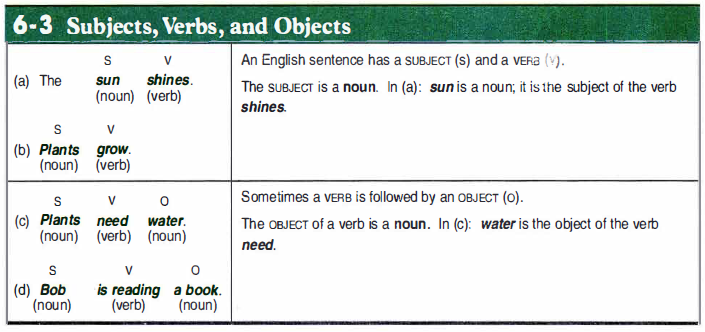
A sentence usually has:
✅ (1) Subject (Who or what does the action?)
✅ (2) Verb (Action or state of being)
✅ (3) Object (Receives the action, if needed)
📌 Examples:
| Sentence | Subject | Verb | Object |
|---|---|---|---|
| She reads a book. | She | reads | a book |
| They are playing soccer. | They | are playing | soccer |
| Tom loves pizza. | Tom | loves | pizza |
✅ Without an object: He sleeps early. (No object needed!)
6-4 Objects of prepositions

When a preposition (in, on, at, with, to, etc.) is followed by a noun or pronoun, that noun or pronoun is the object of the preposition.
✅ Examples:
- I sat on the chair. → (“chair” is the object of “on”)
- She talked to him. → (“him” is the object of “to”)
- We traveled with our friends. → (“friends” is the object of “with”)
6-5 Prepositions of time

📌 Common Time Prepositions:
| Preposition | Usage | Example |
|---|---|---|
| At | Specific time | At 7 PM, at noon |
| On | Days & dates | On Monday, on July 4th |
| In | Months, years, centuries, long periods | In May, in 2024, in the morning |
✅ Examples:
- I was born in 1995.
- She left at noon.
- We met on Monday.
6-6 Word order: place and time

The usual order in English is PLACE before TIME.
📌 Correct Word Order:
| Correct | Incorrect |
|---|---|
| I study at school in the morning. | ❌ I study in the morning at school. |
| We met in the park yesterday. | ❌ We met yesterday in the park. |
✅ Examples:
- She arrived at the airport in the evening.
- They had dinner at a restaurant last night.
6-7 Subject-verb agreement

A singular subject takes a singular verb, and a plural subject takes a plural verb.
📌 Basic Rules:
| Subject | Verb | Example |
|---|---|---|
| Singular | verb + s/es | She likes coffee. |
| Plural | base verb | They like coffee. |
| I/You | base verb | I like coffee. |
✅ Examples:
- The boy plays soccer. (singular: boy → plays)
- The boys play soccer. (plural: boys → play)
- She has a car. / They have a car.
📌 Tricky Cases:
| Subject | Verb |
|---|---|
| Everyone (singular) | likes ice cream. |
| The team (singular) | is playing well. |
| The people (plural) | are happy. |
6-8 Using adjectives to describe nouns

Adjectives describe nouns and usually come before the noun.
📌 Order of Adjectives:
| Category | Example |
|---|---|
| Opinion | beautiful, nice, ugly |
| Size | big, small, tall |
| Age | young, old, new |
| Shape | round, square, thin |
| Color | red, blue, green |
| Nationality | American, French, Japanese |
| Material | wooden, metal, plastic |
✅ Examples:
- A big red car (size → color → noun)
- A beautiful old wooden house (opinion → age → material → noun)
- An interesting small green book
6-9 Using nouns as adjectives

Sometimes, a noun can act as an adjective to describe another noun.
📌 Examples:
- A chicken soup → (“chicken” describes the type of soup)
- A computer keyboard → (“computer” describes the type of keyboard)
- A coffee mug → (“coffee” describes the type of mug)
✅ Key Rule:
The first noun (acting as an adjective) is always singular!
❌ A computers keyboard → ✅ A computer keyboard
❌ A shoes store → ✅ A shoe store
6-10 Personal pronouns: subjects and objects

Pronouns replace nouns to avoid repetition.
📌 Personal Pronouns:
| Subject Pronoun | Object Pronoun | Example Sentence |
|---|---|---|
| I | me | I love coffee. / He called me. |
| You | you | You are my friend. / I saw you yesterday. |
| He | him | He is at home. / She met him at work. |
| She | her | She likes music. / We saw her at the park. |
| It | it | It is raining. / I found it in my bag. |
| We | us | We are happy. / She helped us. |
| They | them | They are my friends. / We invited them. |
✅ Examples:
- She loves him. (“him” replaces “John”)
- They saw us at the mall. (“us” replaces “my friends and me”)
6-11 Possessive nouns

Possessive nouns show ownership or possession.
📌 Rules for Forming Possessives:
| Singular Noun | Possessive Form | Example |
|---|---|---|
| boy | boy’s | The boy’s hat is blue. |
| girl | girl’s | The girl’s bike is red. |
| cat | cat’s | The cat’s toy is missing. |
📌 Plural Possessives:
| Plural Noun | Possessive Form | Example |
|---|---|---|
| boys | boys’ | The boys’ room is messy. |
| girls | girls’ | The girls’ team won the game. |
| cats | cats’ | The cats’ food is on the floor. |
✅ Examples:
- My friend’s book (one friend)
- My friends’ books (multiple friends)
6-12 Possessive pronouns and adjectives

Possessive pronouns replace a noun to show ownership, while possessive adjectives modify a noun.
📌 Comparison Chart:
| Possessive Adjective | Possessive Pronoun | Example Sentence |
|---|---|---|
| my | mine | This is my book. / This book is mine. |
| your | yours | Is this your car? / Is this car yours? |
| his | his | That is his jacket. / That jacket is his. |
| her | hers | This is her phone. / This phone is hers. |
| its | its | The dog wagged its tail. |
| our | ours | That is our house. / That house is ours. |
| their | theirs | This is their room. / This room is theirs. |
✅ Examples:
- That car is hers (not “her’s” ❌).
- The house is ours, not theirs.
6-13 Reflexive pronouns

Reflexive pronouns are used when the subject and object are the same person or thing.
📌 Reflexive Pronouns List:
| Subject | Reflexive Pronoun | Example |
|---|---|---|
| I | myself | I made this cake myself. |
| You | yourself | You should believe in yourself. |
| He | himself | He cut himself while cooking. |
| She | herself | She taught herself to play piano. |
| It | itself | The cat cleaned itself. |
| We | ourselves | We fixed the car ourselves. |
| They | themselves | They built the house themselves. |
✅ Examples:
- She hurt herself while skating.
- They did the project themselves.
6-14 Singular forms of other: another vs the other

📌 Key Difference:
Another= one more, an additional oneThe other= the second of two options
✅ Examples:
- Can I have another coffee? (one more coffee)
- I have two pens. One is red, and the other is blue. (refers to the second pen)
6-15 Plural forms of other: other(s) vs the other(s)

📌 Key Difference:
| Word | Meaning | Example |
|---|---|---|
| others | additional things/people (general) | Some people like coffee, but others prefer tea. |
| the others | specific things/people (known group) | Three students went home. The others stayed. |
| other + noun | more of a type | I need other shoes. |
| the other + noun | the remaining | I have two dogs. One is big; the other dog is small. |
✅ Examples:
- Do you have other questions? (general, not specific)
- I read two books. The other was more interesting. (specific second book)
6-16 Summary of forms of other

📌 Summary Table:
| Singular | Plural | Example |
|---|---|---|
| another (one more) | others (additional, general) | I need another cup. / Some people like pizza; others don’t. |
| the other (specific second choice) | the others (specific remaining) | He took one key; the other is mine. / Some students left; the others stayed. |
| other + noun (more of a type) | other + plural noun (more of a type) | I need other information. / There are other books in the library. |
7. MODAL AUXILIARIES

Modal auxiliaries (or modal verbs) help express ability, possibility, permission, politeness, advice, and necessity. They do not change form and are always followed by the base form of the main verb (without to).
Modal auxiliaries are essential for expressing ability, possibility, permission, politeness, and advice.
✅ Key Takeaways:
- Ability: He can swim. / She could run fast.
- Possibility: It may/might/could rain.
- Permission: You may/can leave.
- Politeness: May I / Could I / Would you / Can you?
- Advice: You should/ought to rest.
- Warnings: You had better study.
- Necessity: You must/have to do it.
- Lack of necessity: You don’t have to go.
- Prohibition: You must not enter.
- Logical conclusion: He must be the teacher.
- Tag questions: You can help, can’t you?
- Instructions: Sit down.
- Suggestions: Let’s eat. / Why don’t we go?
- Preferences: I prefer tea. / I would rather drink water.
7-1 The form of modal auxiliaries

Modal auxiliaries do not take -s, -ing, or -ed endings and are followed by the base form of the verb.
📌 Structure:
Subject + Modal Verb + Base Verb + Object
✅ Examples:
- She can swim. (not “can swims” ❌)
- He should study for the exam.
📌 Common Modals:
| Modal | Function | Example |
|---|---|---|
| can | Ability / Permission | I can drive. / You can go now. |
| could | Past ability / Polite request / Possibility | She could run fast. / Could you help me? |
| may | Permission / Possibility | You may leave early. / It may rain. |
| might | Possibility | She might be late. |
| will | Future certainty | We will arrive at 5 PM. |
| would | Hypothetical / Politeness | I would love to help. |
| shall | Future intention / Suggestion | I shall return. / Shall we dance? |
| should | Advice / Expectation | You should rest. |
| must | Strong necessity | You must wear a seatbelt. |
7-2 Expressing ability: can and could
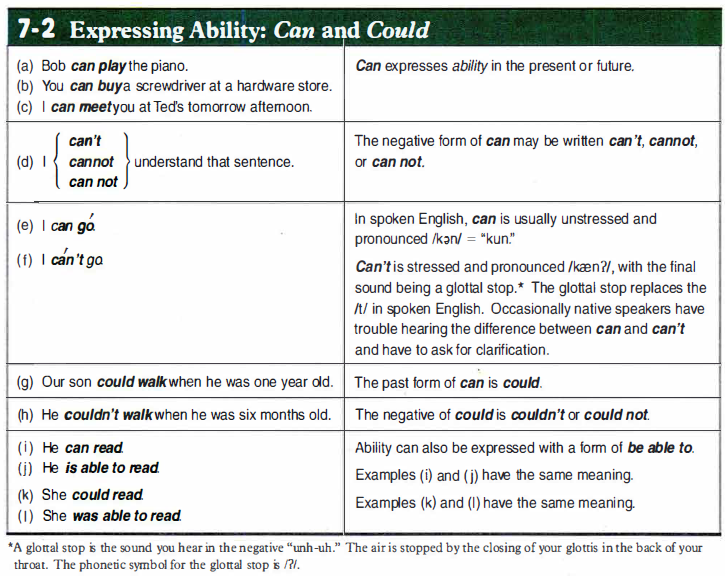
📌 Can is used for present ability, and could is used for past ability or polite requests.
✅ Examples:
- She can swim. (present ability)
- He could run fast when he was younger. (past ability)
- Could you help me? (polite request)
7-3 Expressing possibility: may, might, and maybe; expressing permission: may and can

Permission: may and can**
📌 May and might express possibility:
- It may rain tomorrow. (possible)
- She might be at home. (less certain)
📌 May and can express permission:
- You may enter the room. (formal)
- You can go now. (informal)
📌 Maybe is not a modal but an adverb:
- Maybe she is late. (not “Maybe she may be late” ❌)
7-4 Using could to express possibility

📌 Could suggests a possible but uncertain outcome.
✅ Examples:
- She could win the race. (possible but not certain)
- The key could be in your bag.
7-5 Polite questions: may I, could I, can I

Used to ask for permission politely.
📌 Formal:
- May I leave early?
📌 Less formal:
- Could I sit here?
- Can I borrow your pen?
7-6 Polite questions: would you, could you, will you, can you

Used to ask someone to do something politely.
📌 Most formal:
- Would you please help me?
- Could you open the door?
📌 Less formal:
- Will you help me?
- Can you pass the salt?
7-7 Expressing advice: should and ought to

📌 Should and ought to both mean giving advice or recommendation.
✅ Examples:
- You should sleep early.
- You ought to see a doctor.
📌 Should is more common in speech than ought to.
7-8 Expressing advice: had better

📌 Had better gives strong advice or warning.
✅ Examples:
- You had better study, or you will fail.
- We had better leave now before the storm starts.
📌 Stronger than “should” but softer than “must”.
7-9 Expressing necessity: have to, have got to, must

📌 These modals express necessity or obligation.
✅ Examples:
- You must wear a seatbelt. (strong necessity)
- I have to finish my homework. (external obligation)
- She has got to be on time. (spoken emphasis)
📌 Differences:
- Must is often for strong personal necessity or rules (You must be quiet!).
- Have to refers to external obligations (I have to go to work.).
- Have got to is more common in spoken English (I’ve got to leave now.).
7-10 Expressing lack of necessity: do not have to; Expressing prohibition: must not

📌 Do not have to = Something is not necessary.
📌 Must not = Strict prohibition (not allowed).
✅ Examples:
- You do not have to wake up early tomorrow. (It’s optional.)
- You must not park here. (Strict rule – not allowed.)
7-11 Making logical conclusions: must

📌 Must can also express certainty or logical conclusions.
✅ Examples:
- She must be at work now. (I’m sure she is.)
- It must be cold outside. (Based on the situation, I’m certain.)
7-12 Tag questions with modal auxiliaries

📌 Tag questions are short questions added to the end of a statement to confirm information.
✅ Examples:
- She can swim, can’t she?
- They should help, shouldn’t they?
- You must be tired, mustn’t you?
📌 Positive statement → Negative tag (You can help, can’t you?)
📌 Negative statement → Positive tag (You can’t swim, can you?)
7-13 Giving instructions: imperative sentences

📌 Imperatives are used to give commands, instructions, or advice.
✅ Examples:
- Close the door. (Command)
- Please sit down. (Polite instruction)
- Don’t touch that! (Negative imperative)
📌 Adding “please” makes it more polite (Please turn off the lights.).
7-14 Making suggestions: let's and why don't

📌 Let’s + base verb = Including the speaker in the suggestion.
📌 Why don’t + subject + verb = Making a suggestion to someone.
✅ Examples:
- Let’s go to the beach! (Group suggestion)
- Why don’t we watch a movie? (Casual suggestion)
7-15 Stating preferences: prefer, like...better, would rather


📌 Prefer = General preference
📌 Like…better = Comparison preference
📌 Would rather = Specific preference in a situation
✅ Examples:
- I prefer tea to coffee. (General)
- I like tea better than coffee. (Comparison)
- I would rather drink tea than coffee. (Specific choice)
8. CONNECTING IDEAS

Connecting ideas properly helps create coherent and logical sentences in writing and speech. Different conjunctions are used to show addition, contrast, cause-effect, and choices.
✅ Key Takeaways:
- Addition: I like apples and bananas.
- Contrast: I like apples, but I don’t like oranges.
- Choices: Do you want apples or oranges?
- Cause-effect: It was late, so I went home.
- Avoiding repetition: He likes coffee, but she doesn’t.
- Expressing similarity: He plays soccer, and I do too / so do I.
- Giving reasons: She left because she was tired.
- Showing contrast: She left even though she was tired.
8-1 Connecting ideas with and

📌 And is used to add information or connect similar ideas.
✅ Examples:
- I like coffee, and I like tea.
- She speaks English and Spanish.
📌 And also connects actions happening in sequence:
- She woke up and brushed her teeth.
8-2 Connecting ideas with but and or

📌 But is used to show contrast (opposite ideas).
📌 Or is used to show choices or alternatives.
✅ Examples:
- I like coffee, but I don’t like tea. (contrast)
- Do you want coffee or tea? (choice)
8-3 Connecting ideas with so

📌 So is used to show cause and effect (result).
✅ Examples:
- I was tired, so I went to bed early.
- It was raining, so we stayed inside.
8-4 Using auxiliary verbs after but

📌 Auxiliary verbs (do, does, did, can, will, etc.) are used after but to avoid repetition.
✅ Examples:
- She likes ice cream, but I don’t. (= but I don’t like ice cream.)
- He studied a lot, but she didn’t. (= but she didn’t study.)
📌 This makes sentences shorter and clearer.
8-5 Using and + too, so, either, neither

📌 To express similarity, we use:
too(for positive sentences)so+ auxiliary verb + subjecteither(for negative sentences)neither+ auxiliary verb + subject
✅ Examples:
- She likes pizza, and I do too.
- She likes pizza, and so do I.
- She doesn’t like coffee, and I don’t either.
- She doesn’t like coffee, and neither do I.
📌 So and neither are more formal than too and either.
8-6 Connecting ideas with because

📌 Because introduces a reason or cause.
✅ Examples:
- I stayed home because I was sick.
- He left early because he had a meeting.
📌 Positioning:
Becausecan be at the beginning or middle of a sentence:- Because I was sick, I stayed home.
- I stayed home because I was sick.
8-7 Connecting ideas with even though/although

📌 Even though and although show contrast between two ideas (unexpected results).
✅ Examples:
- She went to work even though she was sick.
- Although it was raining, they played outside.
📌 Even though is stronger than although.
9. COMPARISONS

Comparisons allow us to describe differences and similarities between people, objects, ideas, or situations. They help us express equality, inequality, or the degree of a certain quality. In English, there are several ways to form comparisons using adjectives, adverbs, and nouns. This section will explore different comparative structures and their usage.
🎯 Conclusion
- Comparisons help describe similarities, differences, and degrees of change.
- Comparatives are used to compare two things (bigger, more interesting).
- Superlatives show the highest or lowest degree among three or more things (biggest, most interesting).
- Modifiers like much, slightly, far can adjust the intensity of comparisons.
- Structures like
as...as,less...than, andnot as...ashelp express equal or unequal comparisons. - Double comparatives (the more, the better) show cause-and-effect relationships.
- Repeating comparatives (colder and colder) emphasize gradual change.
- Using words like same, similar, different, like, alike helps express relationships between things.
- Mastering these forms will improve both spoken and written communication.
9-1 Making comparisons with as...as

This structure is used to show that two things are equal or not equal in some way.
✅ Formula:
as + adjective/adverb + as
- Equal comparison:
- She is as tall as her brother. 👦👧 (They are of the same height.)
- He runs as fast as a professional athlete. 🏃💨 (He runs at the same speed.)
- Unequal comparison (negative form):
- This cake is not as sweet as the one I baked yesterday. 🍰
- The test was not as difficult as I expected. 📝
9-2 Comparative and superlative

Comparatives and superlatives are used to compare things.
- Comparative: Used when comparing two things.
- Superlative: Used when comparing three or more things, showing the highest or lowest degree.
📌 Examples:
- This book is more interesting than that one. 📚
- This is the most interesting book I have ever read. 📖
9-3 Comparative and superlative forms of adjectives and adverbs

Adjectives and adverbs change their forms when used in comparisons:
1️⃣ One-Syllable Adjectives
📌 Add -er for the comparative and -est for the superlative.
- small → smaller → smallest 🏠
- fast → faster → fastest 🚗💨
2️⃣ Two or More Syllable Adjectives
📌 Use more for comparatives and most for superlatives.
- beautiful → more beautiful → most beautiful 🌸
- important → more important → most important ✅
3️⃣ Irregular Forms
📌 Some adjectives and adverbs change completely.
- good → better → best 🌟
- bad → worse → worst 🚫
9-4 Completing a comparative

Comparatives often require additional words to complete the meaning, usually using “than.”
📌 Examples:
- The new phone is cheaper than the old model. 📱
- This road is wider than the previous one. 🛣️
9-5 Modifying comparatives

We can modify comparatives using words that show degree:
✅ Modifiers: much, far, a little, slightly, significantly
📌 Examples:
- This jacket is much warmer than that one. 🧥🔥
- The new version is slightly better than the old one. 🎮
9-6 Comparisons with less...than and not as...as

These structures show that something is of a lower degree.
📌 Examples:
- This chair is less comfortable than the sofa. 🪑
- This exam was not as hard as I expected. 🏫
9-7 Using more with nouns

“More” can be used with both countable and uncountable nouns to indicate a greater quantity.
📌 Examples:
- She has more books than her brother. 📚
- I need more water to finish cooking. 💧
9-8 Repeating a comparative

Repeating a comparative shows gradual change.
📌 Examples:
- The weather is getting colder and colder. ❄️
- She is becoming more and more confident. 💪
9-9 Using double comparatives

Double comparatives show a cause-and-effect relationship.
📌 Examples:
- The more you practice, the better you become. 🎸
- The faster you run, the sooner you’ll finish. 🏃
9-10 Using superlatives

Superlatives express the highest or lowest degree among three or more things.
📌 Examples:
- This is the most expensive restaurant in town. 🍽️
- She is the smartest student in the class. 🎓
9-11 Using the same, similar, different, like, alike
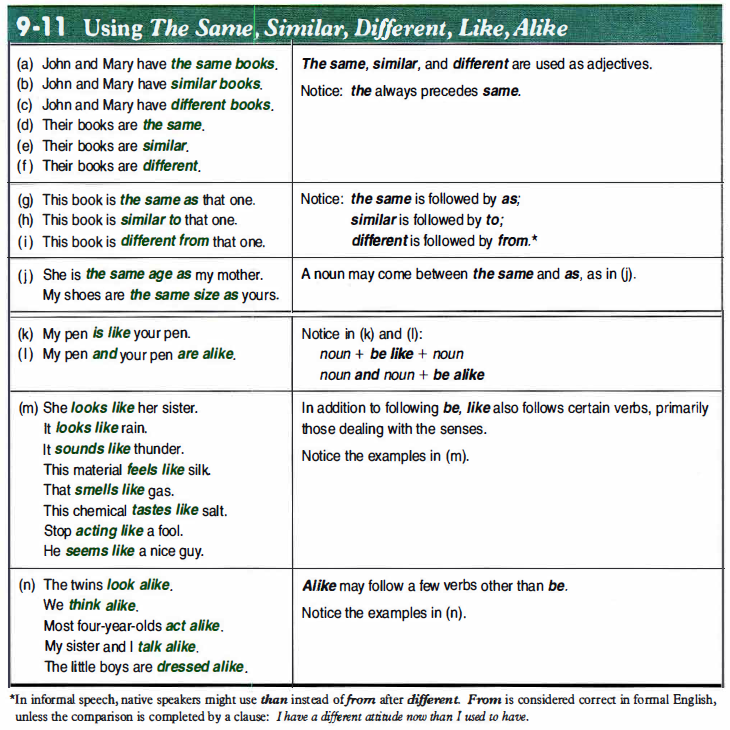
These words express similarity or difference between things.
📌 Examples:
- This phone is the same as mine. 📱📱
- These two designs are similar but not identical. 🎨
- Her answer was different from his. ❌
10. THE PASSIVE

The passive voice is used when the focus is on the action rather than the person or thing performing the action. It is commonly used in formal writing, news reports, and scientific descriptions.
✅ Active: The chef cooked the meal. 👨🍳
✅ Passive: The meal was cooked by the chef. 🍽️
The passive is useful when:
- The doer of the action is unknown or unimportant.
- The focus is on the result rather than the subject performing the action.
- The speaker wants to be indirect or impersonal (e.g., official or formal statements).
What you will learn:
- The passive voice shifts the focus to the action rather than the doer.
- Passive sentences use be + past participle (V3) and change depending on tense.
- Transitive verbs can be passive, but intransitive verbs cannot.
- The by-phrase is optional and only used when the doer is important.
- Modal verbs in the passive use modal + be + past participle (must be done).
- Past participles can act as adjectives (a broken window).
-edand-ingadjectives have different meanings (bored vs. boring).Get+ adjective/past participle is common in informal speech (get tired, get fired).- Be used to = familiarity; get used to = adaptation.
Be supposed toexpresses obligations or expectations.
10-1 Active sentences and passive sentences

1️⃣ What is the Difference?
- Active Voice: The subject performs the action.
- Example: A famous artist painted this picture. 🎨
- Passive Voice: The object becomes the subject, and the action is emphasized.
- Example: This picture was painted by a famous artist. 🖼️
📌 When to use Passive?
- When the action is more important than the doer.
- When the doer is unknown, obvious, or irrelevant.
- In scientific, academic, or official writing.
10-2 Form of the passive
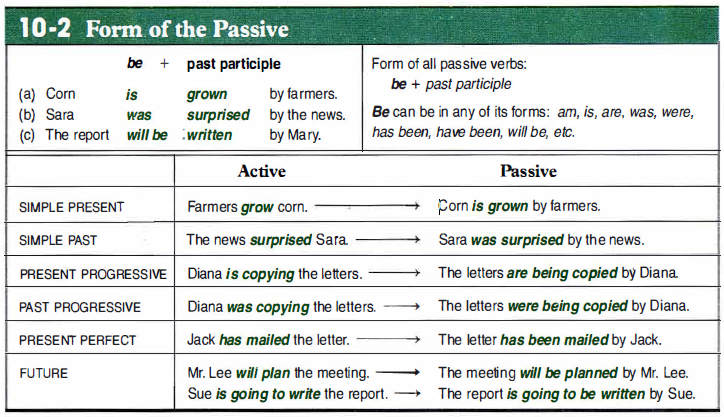

📌 Formula:
✅ be + past participle (V3)
| Tense | Active | Passive |
|---|---|---|
| Present Simple | They make cars. 🚗 | Cars are made. 🏭 |
| Past Simple | They built the house. 🏠 | The house was built. 🏗️ |
| Future | They will finish the project. | The project will be finished. |
| Present Perfect | They have repaired the road. | The road has been repaired. |
🔹 Examples:
- A new bridge is being built in the city. 🌉 (Present continuous)
- The results will be announced tomorrow. 📢 (Future)
10-3 Transitive and intrasitive verbs

1️⃣ Transitive Verbs (Can Be Passive)
- Verbs that require an object can form passive sentences.
- Example (Active): They wrote the report. 📝
- Example (Passive): The report was written.
2️⃣ Intransitive Verbs (Cannot Be Passive)
- Verbs that do not take an object cannot be passive.
- ❌ “He arrived at 7 PM.” → No passive form!
💡 Common intransitive verbs: arrive, go, sleep, exist, happen, die.
10-4 Using the by-phrase

The by-phrase introduces the doer of the action in passive sentences.
📌 Examples:
- The novel was written by J.K. Rowling. 📖
- The window was broken by a strong wind. 🌬️
💡 When to Omit by?
- If the doer is unknown, general, or unimportant.
- “A cure for the disease has been discovered.” (Who discovered it is not important.)
10-5 Passive modal auxiliaries

Modal verbs (can, must, should, may, might, etc.) are used in passive structures.
📌 Formula:
✅ modal + be + past participle
🔹 Examples:
- The rules must be followed. 📜
- The work should be completed by Monday. ⏳
- A decision can be made later. 🤔
10-6 Using past participles as adjectives (non-progressive passive)

Past participles (V3) can act as adjectives to describe a state or condition.
📌 Examples:
- The closed doors made the room dark. 🚪
- The broken glass was dangerous. 🏺
💡 Difference:
- The door was closed by someone. (Passive)
- The closed door kept out the noise. (Adjective)
10-7 Participial adjectives: -ed vs -ing

-edadjectives → Describe feelings.- I am bored by the movie. (I feel this way.)
-ingadjectives → Describe characteristics of things.- The movie is boring. 🎥
📌 More Examples:
- She felt tired after work. 💤
- It was an exciting match! ⚽
10-8 Get + adjective; get + past participle

📌 Formula:
✅ get + adjective → Change of state
✅ get + past participle → Passive meaning
🔹 Examples:
- She got sick after eating bad food. 🤒
- The car got repaired yesterday. 🚗🔧
💡 "Get" is often used in informal speech instead of "be".
10-9 Using be used/accutomed to and get used/accustomed to

1️⃣ Be Used to (Familiarity) ✅ be used to + noun/gerund (V-ing)
- I am used to waking up early. ⏰
2️⃣ Get Used to (Process of Adapting) ✅ get used to + noun/gerund (V-ing)
- She got used to the cold weather. ❄️
10-10 Used to to be used to

🔹 Used to + verb → Past habits/actions (no longer true).
- I used to play football. (I don’t anymore.)
🔹 Be Used to + noun/V-ing → Familiarity with something.
- I am used to waking up early.
10-11 Using be supposed to

📌 Formula:
✅ be supposed to + base verb → Shows obligation, expectation, or assumption.
🔹 Examples:
- You are supposed to finish your homework. 📚 (Obligation)
- The train is supposed to arrive at 6 PM. 🚆 (Expectation)
11. COUNT/NONCOUNT NOUNS AND ARTICLES

Nouns in English are classified as countable (count nouns) or uncountable (noncount nouns). Understanding this distinction helps in using articles (a, an, the), quantifiers (some, many, much, a few), and correct grammar.
What you will learn:
- Articles (
a, an, the) help define nouns clearly. - Count nouns can be singular/plural; noncount nouns cannot.
- Some nouns can be both countable and uncountable based on context.
- Quantifiers like many/much, a few/a little differ based on noun type.
- Units of measurement make noncount nouns countable (a piece of advice).
- Capitalization follows strict rules for proper nouns and sentences.
11-1 A vs an

A and an are indefinite articles used with singular count nouns.
When to Use?
✅ A → Before words beginning with a consonant sound.
✅ An → Before words beginning with a vowel sound.
📌 Examples:
- I saw a cat outside. 🐱
- She ate an apple. 🍏
- He is an honest person. (Silent ‘h’, so vowel sound!)
🚨 Common Mistakes:
- ❌ An university → ✅ A university (because ‘university’ starts with a consonant sound: “yoo”)
- ❌ A hour → ✅ An hour (because ‘hour’ starts with a vowel sound: “ow”)
11-2 Count and noncount nouns

1️⃣ Countable Nouns (Count Nouns)
- Things that can be counted (one, two, three…).
- Can have singular and plural forms.
📌 Examples:
- One chair, two chairs 🪑
- A book, many books 📚
2️⃣ Uncountable Nouns (Noncount Nouns)
- Things that cannot be counted individually.
- They do not have plural forms.
📌 Examples:
- Water, sugar, information, furniture 🚰
🚨 Common Mistakes:
- ❌ Two informations → ✅ Two pieces of information
- ❌ A bread → ✅ A loaf of bread
11-3 Noncount nouns

Some common categories of uncountable nouns:
- Liquids & Gases: Water, milk, juice, air, oxygen
- Substances & Materials: Sugar, gold, wood, cotton
- Abstract Ideas: Love, happiness, advice, knowledge
- Natural Phenomena: Weather, rain, snow, lightning
📌 Examples:
- She gave me good advice (not “an advice”) 💡
- I need some water (not “a water”) 💧
11-4 More noncount nouns
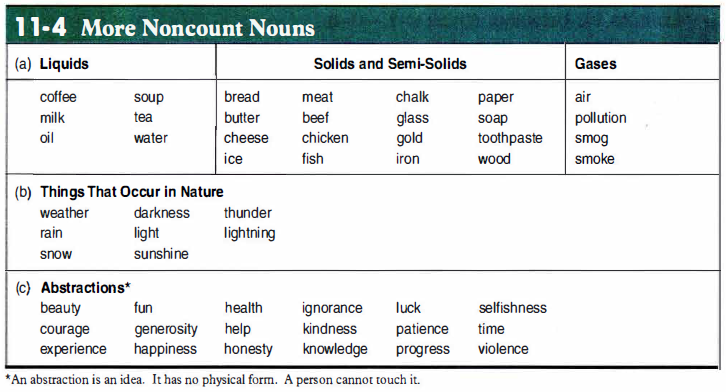
Some nouns look plural but are actually singular.
📌 Examples:
- News (The news is interesting.) 📰
- Mathematics (Mathematics is my favorite subject.) 🏫
- Economics (Economics is difficult.) 💰
🚨 Common Mistakes:
- ❌ These news are good! → ✅ This news is good!
11-5 Using several, a lot of, many/much, and a few/a little

1️⃣ Words for Countable Nouns:
- Several (I have several friends.)
- A few (I have a few questions.)
- Many (There are many cars in the parking lot.)
2️⃣ Words for Uncountable Nouns:
- A little (There is a little milk left.)
- Much (I don’t have much time.)
3️⃣ Words for Both Count and Noncount Nouns:
- A lot of (I have a lot of books / There is a lot of water.)
- Some (She bought some apples / She bought some bread.)
🚨 Common Mistakes:
- ❌ I have much friends → ✅ I have many friends
- ❌ I drank many water → ✅ I drank much water
11-6 Nouns that can be count or noncount

Some nouns can be both countable and uncountable, depending on meaning.
📌 Examples:
- Chicken (Noncount = food 🥩) → I ate chicken for dinner.
-
Chicken (Count = animal 🐔) → There are three chickens in the yard.
- Hair (Noncount = all hair on head) → She has beautiful hair. 💇♀️
- Hair (Count = individual strands) → I found a hair in my soup! 😱
11-7 Using units of measure with noncount nouns

Since noncount nouns cannot be counted directly, we use units of measure.
📌 Examples:
- A glass of water 🥛
- A slice of pizza 🍕
- A piece of furniture 🪑
🚨 Common Mistakes:
- ❌ Three breads → ✅ Three loaves of bread
11-8 Guidelines for article usage
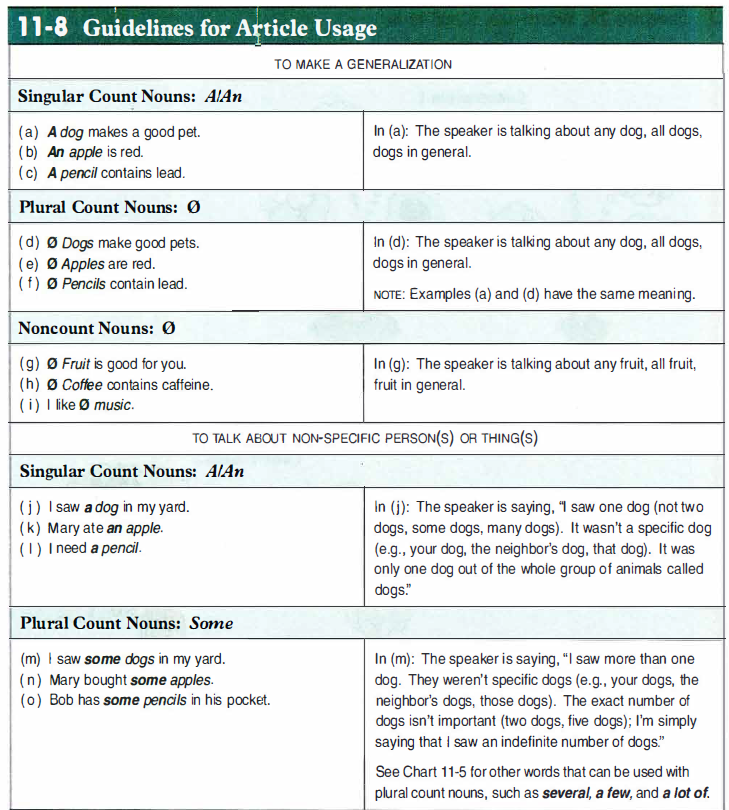

| Article | Usage | Example |
|---|---|---|
A / An |
First mention of something | I saw a dog. 🐶 |
The |
Specific things, already mentioned | The dog was friendly. 🐕 |
| No article (Ø) | General ideas, uncountable nouns, plural count nouns | Love is important. ❤️ |
📌 Examples:
- I need a phone. (Any phone, not specific)
- I need the phone on the table. (A specific phone)
- She loves Ø music. (General idea)
11-9 Using the or O with names
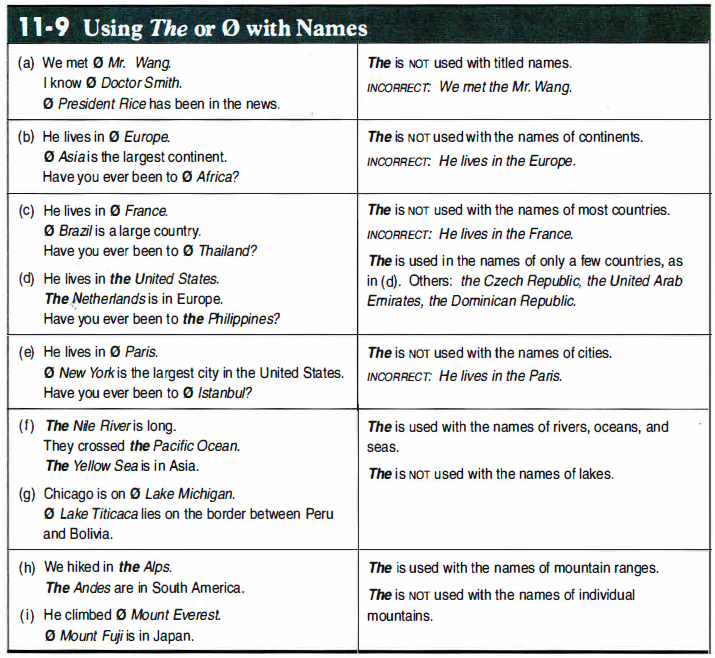
| Use “The” | No “The” (Ø) |
|---|---|
| Oceans & Seas: The Atlantic Ocean 🌊 | Continents: Asia, Europe 🌏 |
| Rivers: The Nile 🌊 | Countries: Brazil, Japan 🇧🇷🇯🇵 |
| Hotels/Theaters: The Hilton Hotel 🏨 | Cities: Paris, Tokyo 🏙️ |
| Newspapers: The New York Times 📰 | Names: John, Sarah 👩🦰 |
11-10 Capitalization


Capitalization rules:
- First word of a sentence: The weather is nice.
- Proper nouns: I live in New York. 🗽
- Days & months: Monday, January
- Titles: Dr. Smith, President Biden
🚨 Common Mistakes:
- ❌ i live in france. → ✅ I live in France.
- ❌ monday is a holiday. → ✅ Monday is a holiday.
12. ADJECTIVE CLAUSES

An adjective clause (also called a relative clause) is a dependent clause that describes or gives more information about a noun.
- It usually starts with relative pronouns (who, whom, whose, which, that) or relative adverbs (where, when, why).
📌 Example:
- The girl who lives next door is my best friend.
- The book that I borrowed was interesting.
Why use adjective clauses?
✅ They help combine sentences.
✅ They make writing smoother and more natural.
What you will learn:
- Adjective clauses give extra information about nouns.
- Who/whom/that refer to people; which/that refer to things.
- Whose is used for possession.
- Prepositions can be placed at the end or before the relative pronoun.
- Verb agreement in the clause must match the noun.
12-1 Adjective clauses: introduction

An adjective clause acts like an adjective and modifies a noun.
📌 Examples:
- She met a man who speaks five languages.
- I have a car that runs on electricity. 🚗⚡
Adjective Clause Structure:
Relative Pronoun/Adverb + Subject + Verb
📌 Examples:
- The house where I was born is still standing.
- The teacher who taught me math is retiring.
12-2 Using who and that in adjective clauses to describe people

Relative Pronouns for People:
- Who → Refers to the subject (he/she/they).
- That → Can replace who in informal speech.
📌 Examples:
- The doctor who treated me was very kind. 👨⚕️
- The woman that lives next door is an artist.
🚨 Common Mistakes:
- ❌ The teacher which helped me was nice.
- ✅ The teacher who helped me was nice.
12-3 Using object pronouns in adjective clauses to describe people
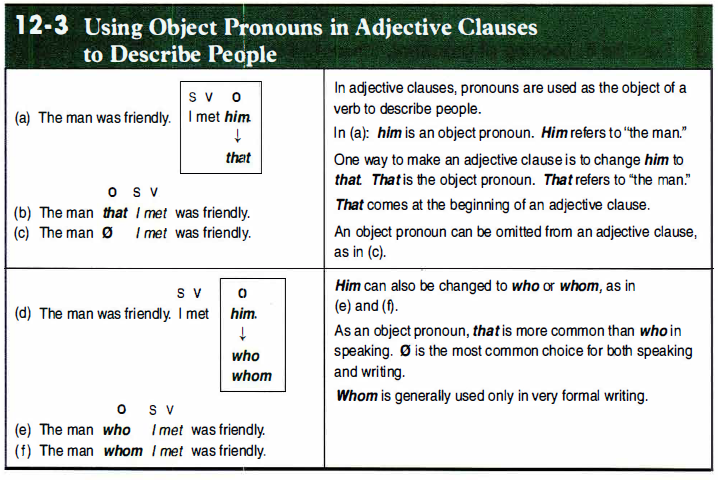
When the person is the object of the clause, we use:
- Whom (formal)
- Who / That (common in spoken English)
📌 Examples:
- The woman whom I met was very friendly. (Formal)
- The woman who I met was very friendly. (Less formal)
- The woman that I met was very friendly. (Common)
🚨 Whom is rarely used in spoken English!
12-4 Using pronouns in adjective clauses to describe things

Relative Pronouns for Things:
- Which → Used for things only.
- That → Used for things (and sometimes people in informal speech).
📌 Examples:
- The phone which I bought is very expensive. 📱
- The book that I’m reading is amazing. 📖
🚨 Common Mistakes:
- ❌ The phone who I bought is expensive.
- ✅ The phone which I bought is expensive.
12-5 Singular and plural verbs in adjective clauses

The verb in the adjective clause must agree with the noun it modifies.
📌 Examples:
- The student who studies hard gets good grades. (Singular)
- The students who study hard get good grades. (Plural)
🚨 Common Mistakes:
- ❌ The boy who play soccer is talented.
- ✅ The boy who plays soccer is talented.
12-6 Using prepositions in adjective clauses

Prepositions can appear inside or at the end of an adjective clause.
📌 Examples:
- The movie which we talked about was amazing. 🎬
- The restaurant that I ate at was delicious. 🍽️
More Formal:
- The movie about which we talked was amazing.
- The restaurant at which I ate was delicious.
🚨 Common Mistakes:
- ❌ The book which I am interested is great.
- ✅ The book that I am interested in is great.
12-7 Using whose in adjective clauses
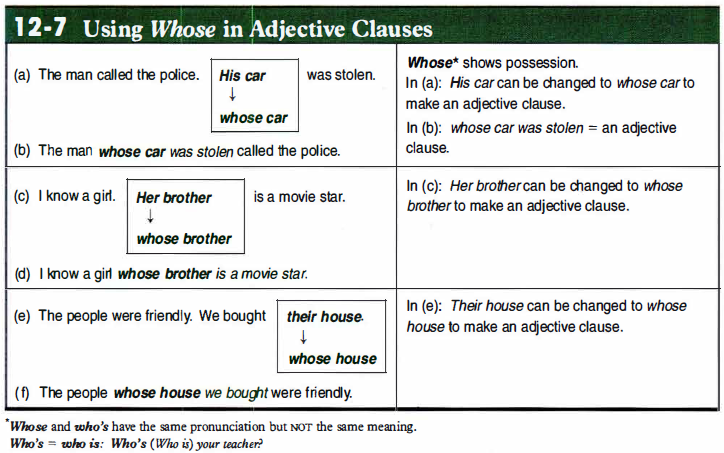
Whose shows possession and replaces his, her, their, its.
📌 Examples:
- The man whose car was stolen is my neighbor. 🚗
- She is the teacher whose lessons I love.
🚨 Common Mistakes:
- ❌ The man who car was stolen is my neighbor.
- ✅ The man whose car was stolen is my neighbor.
13. GERUNDS AND INFINITIVES

In English, verbs are often followed by another verb. The second verb is either in the gerund form (-ing) or the infinitive form (to + base verb).
Understanding when to use gerunds and infinitives correctly helps improve fluency and clarity in writing and speaking.
📌 Examples:
- I enjoy reading books. (Gerund) 📚
- She decided to travel abroad. (Infinitive) ✈️
What you will learn:
- Gerunds (-ing) follow certain verbs (enjoy, avoid, suggest, finish, keep).
- Infinitives (to + verb) follow other verbs (want, decide, plan, refuse).
- Some verbs can take both gerunds and infinitives, but the meaning may change (stop smoking vs. stop to smoke).
- Prepositions must always be followed by gerunds (good at painting).
- “By” + gerund explains how something happens (learn by practicing).
- “It + infinitive” makes general statements (It’s easy to learn English).
- “Too” and “enough” express excess or sufficiency (too cold to swim / warm enough to go outside).
13-1 Verb + gerund

Some verbs must be followed by a gerund (-ing form) instead of an infinitive.
Common verbs followed by a gerund:
✅ enjoy, avoid, consider, dislike, finish, keep, miss, practice, suggest
📌 Examples:
- She enjoys reading novels. 📖
- I avoid eating junk food. 🍔❌
- They suggested going to the beach. 🏖️
🚨 Common Mistakes:
- ❌ He enjoys to swim. → ✅ He enjoys swimming.
13-2 Go + -ing

The verb “go” is often followed by a gerund to describe activities.
📌 Examples:
- They go swimming every weekend. 🏊
- We went hiking in the mountains. 🏔️
- Let’s go shopping tomorrow. 🛍️
13-3 Verb + infinite

Some verbs must be followed by an infinitive (to + verb).
Common verbs followed by an infinitive:
✅ agree, decide, hope, learn, need, plan, promise, refuse, want, would like
📌 Examples:
- I decided to study abroad. 🎓
- She wants to buy a new car. 🚗
- They promised to help us. 🤝
🚨 Common Mistakes:
- ❌ He decided going home. → ✅ He decided to go home.
13-4 Verb + gerund or infinitive

Some verbs can be followed by either a gerund or an infinitive, but the meaning changes.
| Verb | Gerund Meaning (-ing) | Infinitive Meaning (to + verb) |
|---|---|---|
| Forget | Forget a past action (I forgot locking the door.) | Forget to do something in the future (I forgot to lock the door.) |
| Stop | Stop an activity (He stopped smoking. 🚭) | Stop to do something else (He stopped to smoke.) |
| Try | Experiment with something (Try eating more vegetables.) | Attempt to do something (Try to eat more vegetables.) |
📌 Examples:
- I stopped smoking last year. 🚭 (Quit smoking)
- I stopped to smoke a cigarette. 🚬 (Paused an activity to smoke)
🚨 Common Mistakes:
- ❌ I stopped to watch TV. → ✅ I stopped watching TV. (If you quit watching)
13-5 Preposition + gerund

A preposition must always be followed by a gerund (-ing form).
📌 Examples:
- She is good at painting. 🎨
- He is afraid of flying. ✈️
- They talked about going on vacation. 🌴
🚨 Common Mistakes:
- ❌ She is interested to read. → ✅ She is interested in reading.
13-6 Using by and with to express how something is done

- By + gerund → Shows how something happens
- With + noun → Shows what tool is used
📌 Examples:
- She improved her English by practicing every day. 📚
- He opened the can with a knife. 🔪
🚨 Common Mistakes:
- ❌ He learned English by to study. → ✅ He learned English by studying.
13-7 Using gerunds as subjects; using it + infinitive

A gerund can act as the subject of a sentence.
An infinitive can be used with “it” to express general statements.
📌 Examples:
- Swimming is fun. (Gerund as subject) 🏊
- It is important to eat healthy. (It + infinitive) 🥗
🚨 Common Mistakes:
- ❌ To swim is fun. → ✅ Swimming is fun.
13-8 It + infinitive: using for (someone)

We use “for” before a noun or pronoun to specify who the action applies to.
📌 Examples:
- It is difficult for children to understand. 🧒
- It was important for me to apologize.
🚨 Common Mistakes:
- ❌ It is necessary to them to study. → ✅ It is necessary for them to study.
13-9 Expressing purpose with in order to and for
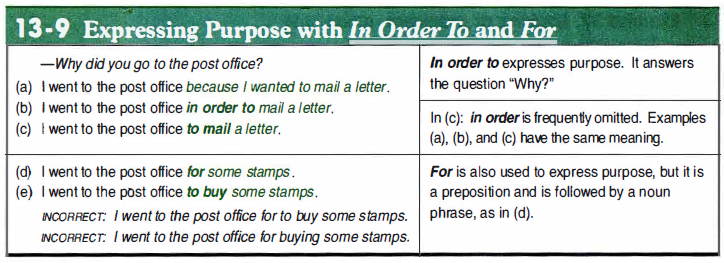
- In order to + verb → Explains purpose
- For + noun → Explains purpose with a noun
📌 Examples:
- She studies in order to pass the exam. 🎓
- This tool is for cutting wood. 🔪
🚨 Common Mistakes:
- ❌ He works hard for buy a car. → ✅ He works hard in order to buy a car.
13-10 Using infinitives with too and enough

- Too + adjective + infinitive → Shows excess (negative meaning)
- Adjective + enough + infinitive → Shows sufficiency (positive meaning)
📌 Examples:
- She is too tired to work. 😴 (She can’t work because she’s exhausted.)
- He is strong enough to lift the box. 💪 (He has enough strength.)
🚨 Common Mistakes:
- ❌ She is too tired work. → ✅ She is too tired to work.
14. NOUN CLAUSES

A noun clause is a dependent clause that functions as a noun in a sentence.
- It can act as a subject, object, or complement.
- Noun clauses often start with question words, if/whether, or that.
📌 Examples:
- What she said** was interesting. (Noun clause as subject)
- I don’t know where he went. (Noun clause as object)
- The fact that she is studying hard is impressive. (Noun clause as complement)
What you will learn:
- Noun clauses function as subjects, objects, or complements.
- Question words (who, what, where, when, why, how) introduce noun clauses.
- If/whether introduces yes/no question clauses.
- That-clauses are used after verbs, adjectives, and nouns.
- In conversation, “so” replaces “that-clauses” (I think so instead of I think that he is coming).
- Quoted speech uses exact words, while reported speech shifts tenses.
- Common reporting verbs include say, tell, ask, reply.
14-1 Noun clauses: introduction

A noun clause takes the place of a noun in a sentence.
📌 Examples:
- She didn’t understand why he left.
- I believe that he is telling the truth.
Noun Clause Functions:
✅ As the subject: What he said was true.
✅ As the object: She explained why she was late.
✅ As a complement: The problem is that he forgot.
🚨 Common Mistakes:
- ❌ I don’t know where is he. → ✅ I don’t know where he is.
14-2 Noun clauses that begin with a question word

A noun clause can begin with a question word (who, what, where, when, why, how).
📌 Examples:
- I don’t know where she went.
- Can you tell me what time it is?
- They explained how they solved the problem.
🚨 Word Order Rule:
- In noun clauses, the sentence does NOT follow question order.
- ❌ I don’t know where did she go.
- ✅ I don’t know where she went.
14-3 Noun clauses that begin with if or whether

Use if or whether to introduce a noun clause when reporting a yes/no question.
📌 Examples:
- I don’t know if he is coming.
- She asked whether we needed help.
- Tell me if you understand.
🚨 Whether vs. If:
- Whether is more formal and can be used before “or not.”
- I don’t know whether or not she likes sushi.
- If is more common in everyday speech.
14-4 Noun clauses that begin with that
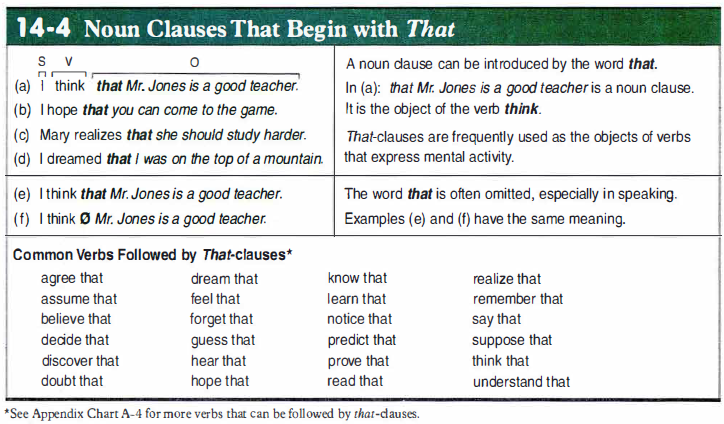
A that-clause acts as a noun in the sentence.
📌 Examples:
- She believes that he is honest.
- The fact that she passed the exam made her happy.
- I’m sure that everything will be fine.
🚨 “That” is often omitted in speech:
- She believes he is honest. (Omitting “that” is common)
14-5 Other uses of that-clauses


A that-clause can be used after adjectives, nouns, and certain verbs.
📌 Examples:
- I am happy that you are here. (After an adjective) 😊
- The truth is that he lied. (After a noun)
- We decided that we should leave early. (After a verb)
🚨 Common Mistakes:
- ❌ I am happy you are here. → ✅ I am happy that you are here.
14-6 Substituting so for a that-clause in conversational responses

In casual conversation, we often replace a that-clause with so to avoid repetition.
📌 Examples:
- A: “Is she coming?”
B: “I think so.” (Instead of “I think that she is coming.”) - A: “Did he pass the test?”
B: “I hope so.” (Instead of “I hope that he passed the test.”)
🚨 Common Mistakes:
- ❌ I don’t think so that he is coming. → ✅ I don’t think so.
14-7 Quoted speech
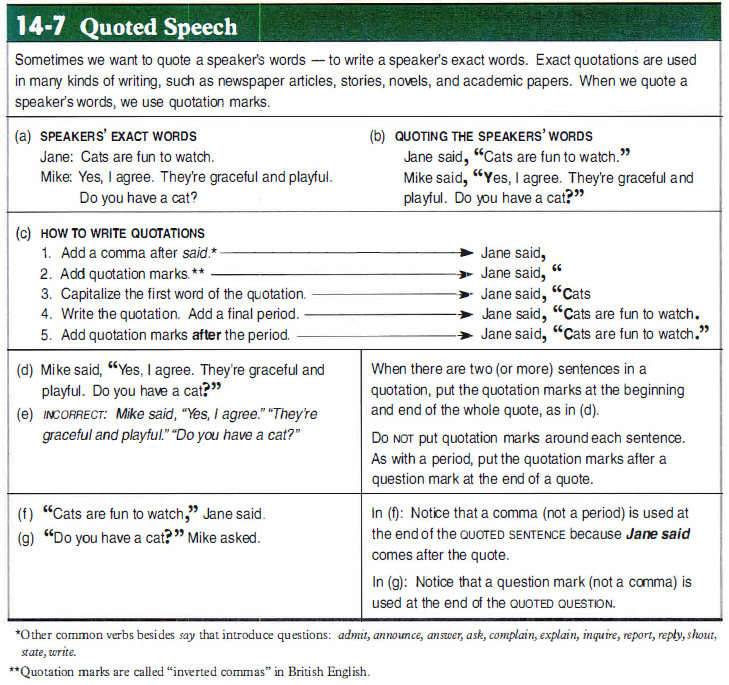
Quoted speech (direct speech) repeats the exact words of a speaker.
📌 Examples:
- She said, “I love pizza.” 🍕
- He asked, “Where are you going?”
🚨 Punctuation Rule:
- Use quotation marks and follow the original sentence structure.
14-8 Quoted speech vs reported speech

Quoted speech (direct speech) repeats the exact words, while reported speech (indirect speech) changes them.
📌 Examples:
- Quoted Speech: He said, “I am tired.”
- Reported Speech: He said that he was tired.
🚨 Changes in Reported Speech:
- Tenses change:
- “I am happy” → He said he was happy.
- “She will come” → He said she would come.
14-9 Verb forms in reported speech
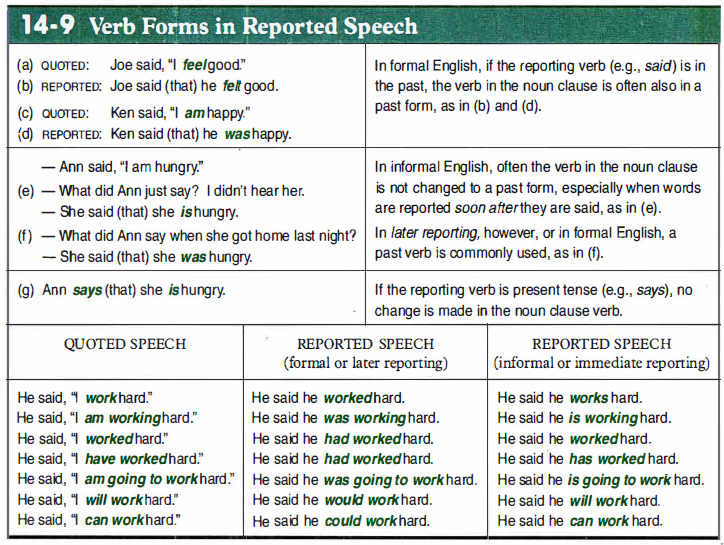
When changing direct speech into reported speech, verb tenses usually shift back (backshifting).
| Direct Speech | Reported Speech |
|---|---|
| “I am tired.” | He said he was tired. |
| “I have finished.” | She said she had finished. |
| “I will go.” | He said he would go. |
📌 Examples:
- “I can help you.” → He said he could help me.
- “She is coming.” → He said she was coming.
🚨 Exceptions:
- If the statement is still true, the tense may not change.
- “The sun rises in the east.” → He said the sun rises in the east.
14-10 Common reporting verbs: tell, ask, answer/reply

When reporting speech, verbs like “tell,” “ask,” “answer,” and “reply” are commonly used.
📌 Examples:
- She told me that she was tired.
- He asked if I needed help.
- She replied that she was busy.
🚨 “Tell” vs. “Say” Rule:
- Tell always needs an object (She told me she was late.).
- Say does not need an object (She said she was late.).
APPENDIX - SUPPLEMENTARY GRAMMAR CHARTS

This appendix provides additional grammar reference materials to clarify specific grammar structures, including verb tenses, phrasal verbs, and preposition combinations.
What you will learn:
- Perfect tenses describe actions before another point in time.
- “Still” shows continuation, while “anymore” shows something has stopped.
- That-clauses follow common verbs (think, say, believe) and expressions (It is clear that…).
- Phrasal verbs combine a verb with a preposition/adverb, changing the meaning.
- Preposition combinations follow specific verbs, adjectives, and nouns (good at, apologize for).
A-1 The present perfect vs the past perfect
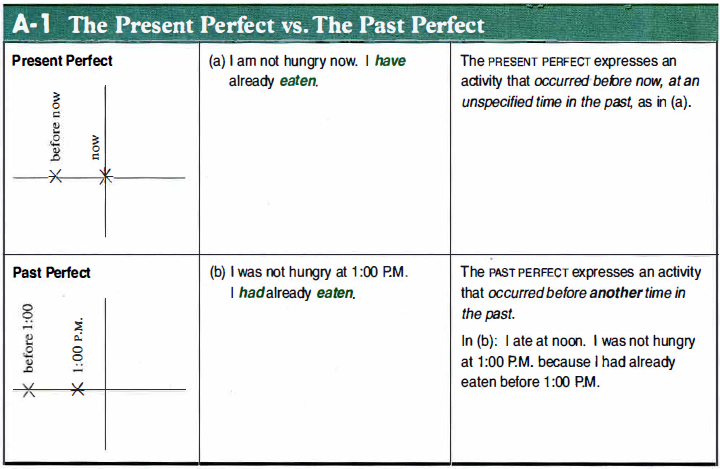
Both tenses describe actions in relation to another point in time, but they are used differently:
✅ Present Perfect (have/has + past participle)
- Describes an action that happened at an unspecified time before now.
- Often used with since, for, already, yet, ever, never.
📌 Examples:
- I have visited Japan twice.
- She has never eaten sushi.
✅ Past Perfect (had + past participle)
- Describes an action that was completed before another past action.
- Often used with before, after, by the time.
📌 Examples:
- I had already eaten when she arrived.
- By the time we got to the station, the train had left.
🚨 Common Mistakes:
- ❌ I have eaten before she arrived. → ✅ I had eaten before she arrived.
A-2 The past progressive vs the past perfect

✅ Past Progressive (was/were + -ing)
- Describes a continuous action happening at a specific time in the past.
- Often used with when, while, as.
📌 Examples:
- I was watching TV when she called.
- They were playing soccer while it was raining.
✅ Past Perfect (had + past participle)
- Describes a completed action before another past event.
📌 Examples:
- She had finished her homework before dinner.
- By the time I arrived, they had left.
🚨 Key Difference:
- Past Progressive focuses on ongoing actions.
- Past Perfect focuses on completed actions before another past event.
A-3 Still vs anyone

✅ Still
- Used in positive sentences to show that something continues.
📌 Examples:
- She still lives in New York.
- Are you still working on your project?
✅ Anymore
- Used in negative sentences to show that something stopped happening.
📌 Examples:
- She doesn’t live in New York anymore.
- I don’t eat fast food anymore.
🚨 Common Mistake:
- ❌ I still don’t like it anymore. → (Choose one: I still don’t like it OR I don’t like it anymore.)
A-4 Additional verbs followed by that-clauses

Some verbs commonly introduce that-clauses (statements).
📌 Examples:
- She believes that she will pass the test.
- I hope that you have a great day!
🚨 Common Verbs that Take That-Clauses:
- Mental Verbs: believe, think, assume, know, guess
- Reporting Verbs: say, tell, mention, explain
- Feeling Verbs: hope, fear, regret, wish
A-5 Additional expressions with be + that-clauses

Certain expressions use “be” + “that-clause” to express opinions or facts.
📌 Examples:
- It is clear that he is unhappy.
- It was obvious that she was excited.
🚨 Common Expressions:
- It is possible that…
- It is likely that…
- It was unfortunate that…
B-1 Phrasal verbs

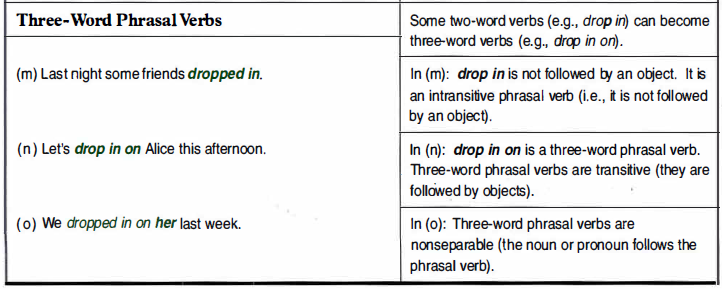
A phrasal verb is a verb followed by a preposition or adverb, changing its meaning.
📌 Examples:
- Turn off (stop using) → Please turn off the lights.
- Give up (quit) → He gave up smoking last year.
🚨 Types of Phrasal Verbs:
✅ Separable: She turned off the TV. (She turned the TV off.)
✅ Inseparable: He ran into his old friend. (❌ He ran his old friend into.)
B-2 Phrasal verbs: a refernce list
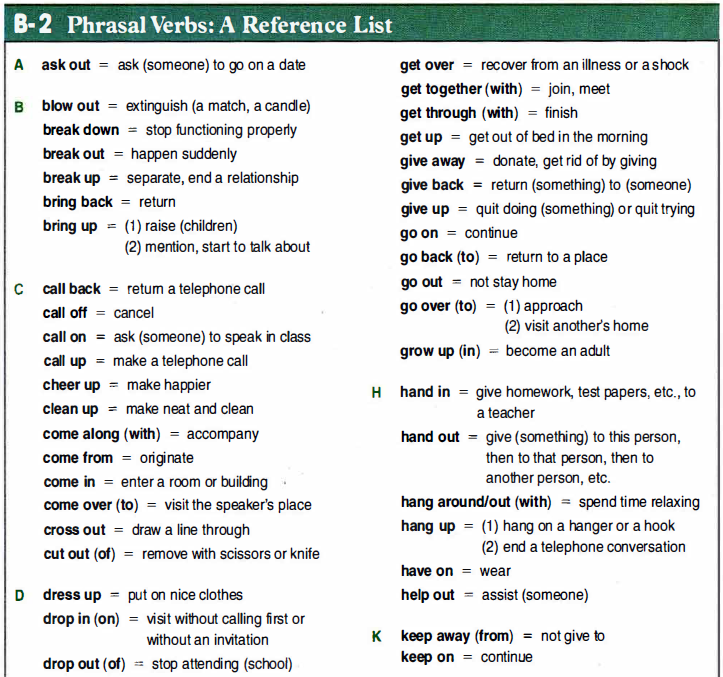
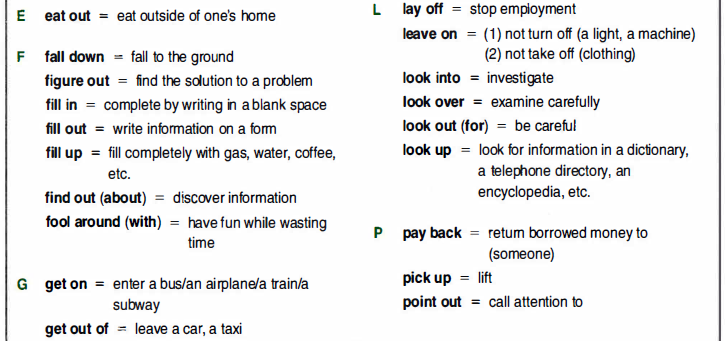

Here are common phrasal verbs and their meanings:
✅ Separable Phrasal Verbs:
- Take off (remove) → She took off her jacket.
- Put on (wear) → He put on his hat.
✅ Inseparable Phrasal Verbs:
- Look after (care for) → She looks after her younger brother.
- Get along with (have a good relationship) → I get along with my coworkers.
C-1 Preposition combinations: introduction

Certain verbs, adjectives, and nouns are always used with specific prepositions.
📌 Examples:
- I am interested in learning English.
- She is good at dancing.
- He is afraid of heights.
C-2 Preposition combinations: a reference list
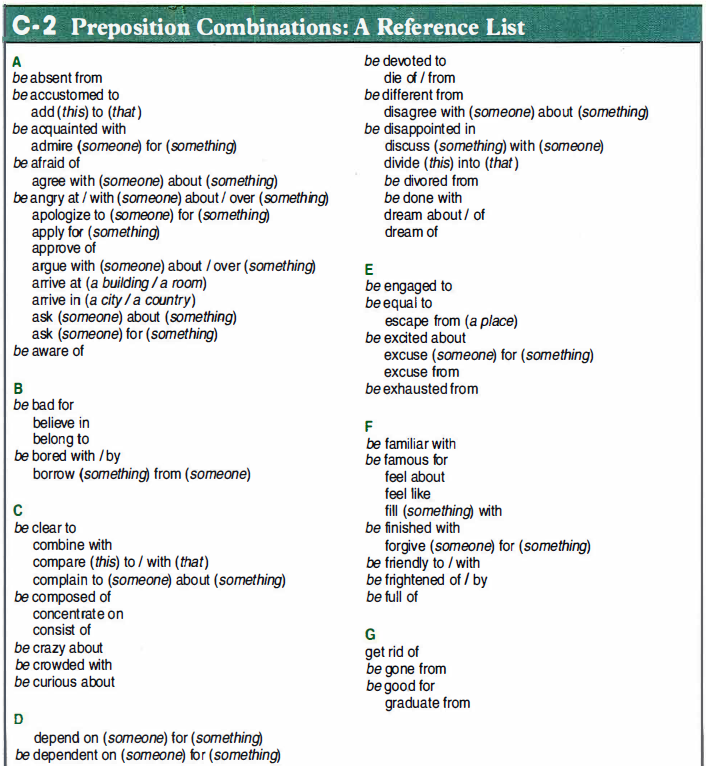
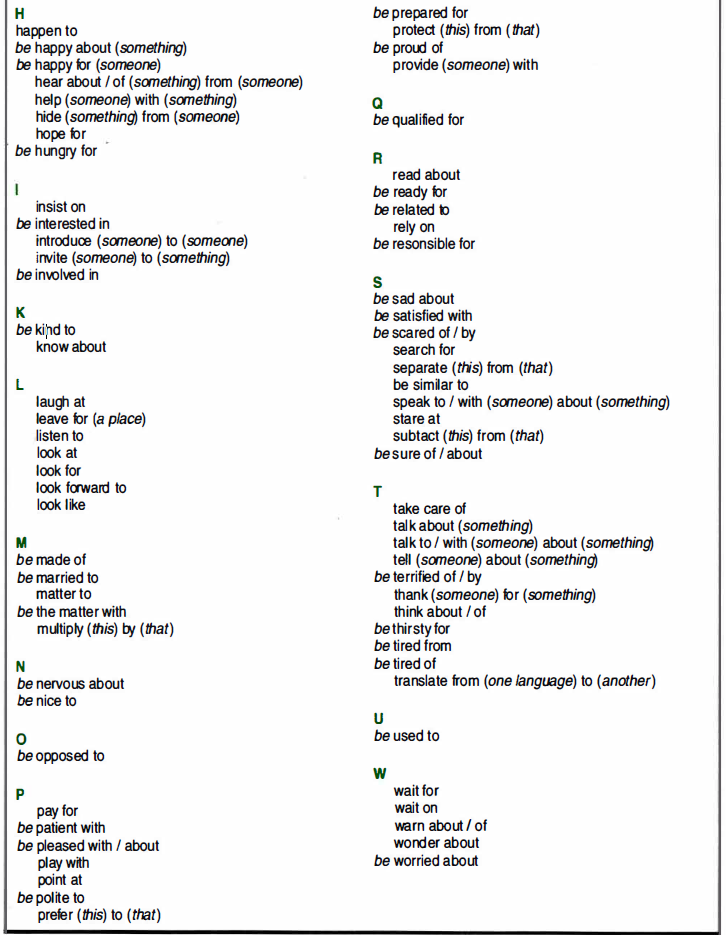
✅ Common Verb + Preposition Combinations:
- Apologize for → He apologized for his mistake.
- Depend on → She depends on her parents.
✅ Common Adjective + Preposition Combinations:
- Excited about → I am excited about the trip.
- Famous for → This city is famous for its food.
✅ Common Noun + Preposition Combinations:
- Reason for → The reason for his absence is unknown.
- Advantage of → What is the advantage of this method?
